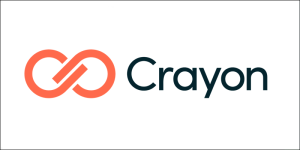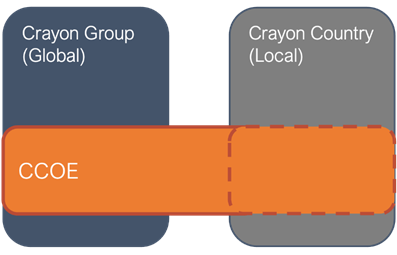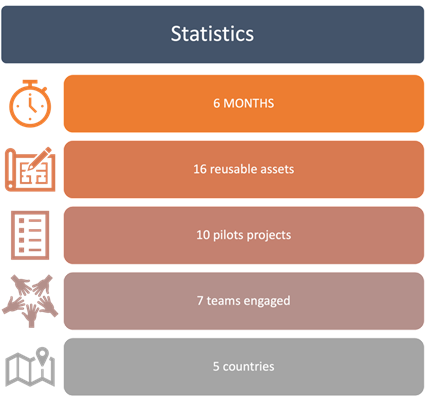AWS Partner Network (APN) Blog
Best Practices from Crayon for Building an Agile Cloud Center of Excellence with AWS
By Francesco Caroli, Cloud Service Development Lead (CCoE) – Crayon
By Anders Thulin Røkke, Vice President Global Services – Crayon
By Steve Drew, Sr. Partner Solutions Architect – AWS
By Thomas Robinson, Manager, Solutions Architecture – AWS
 |
| Crayon |
 |
Crayon is an AWS Premier Tier Services Partner with decades of experience working alongside customers to impactfully transform, manage, benchmark, and optimize their IT estate.
With multiple AWS Competencies and deep skills in software assessment and total cost of ownership (TCO), Crayon helps customers assess their infrastructure, software and applications, select workloads and phasing, architect a complete solution, and define and land their estate on AWS.
In this post, we will provide insight into how Crayon scaled its technical expertise across subsidiaries spanning 40+ countries.
For Crayon, the idea of a Cloud Center of Excellence (CCoE) started from its vision and strategy to accelerate cloud adoption for customers—from cloud strategy, migration, and modernization to managed operations.
The concept of a CCoE formed in the mid-2010s as a way to shape the transformation of an enterprise towards adopting cloud best practices across a global organization. While some of this guidance translates to running a consulting company with global reach, the problems Crayon is solving for customers goes beyond that of a single team, organization, or geography. Crayon’s end goal is to ensure customers receive the same high level of service they expect no matter who at Crayon they meet or where in the world they engage.
A CCoE permeates many things inside an organization. It’s a dedicated department, with dedicated amount of resources, tools, process and responsibilities.
Let’s define the characteristic of such an entity from the nouns that are composing the name:
Figure 1 – Defining a Cloud Center of Excellence.
A Cloud Center of Excellence plays a strategic role when it comes to centralizing the knowledge in order to make solutions available in a quick and repeatable way to different departments in the organization. Hence, as the source of best practices that facilitate the adoption of standardized solutions, the CCoE enables and assures customer services are delivered with the required quality and experience made available to everyone.
Providing specialized advisory services—from pre-sales and project kick-starts to operations and managed services—act as a fundamental, pivotal element for CCoEs to help different departments succeed in the business.
The Value of a Cloud Center of Excellence
The end benefits of a Cloud Center of Excellence can be categorized into three main groups:
- Acceleration: Repeatable IP and automated delivery of the “undifferentiated heavy lifting” to shorten the time to win, start, and deliver solutions and value to end customers. This also results in lower cost for customers, as Crayon does not need to bill for hours of development time solving problems the team has solved before.
- Continuous improvement: By centralizing knowledge through the CCoE and building a culture of collaboration across organizations, Crayon continually improves the services through the lived experience of AWS experts. For example, having global teams iterating on and contributing updates to technical artifacts benefits all of Crayon’s future engagements.
- Modernization: Business improvements for the customers are enabled from the start, but it doesn’t stop there. With a CCoE the solutions are cost optimized and better supported, allowing businesses to grow and perform better.
Prerequisites
If a Cloud Center of Excellence has all of these benefits, what’s keeping more services organizations from adopting this approach?
Global, top-down strategic direction is one reason, as segmentation of global organizations creates barriers to the collaboration required to have a successful CCoE. It has broad impact across its internal customer base, but does not directly generate revenue. Having an executive stakeholder with the ability to recognize the value of improving the global organization and therefore invest in this centralized function is key to the initial formation of the team.
Positioning is another reason CCoEs aren’t leveraged in every organization. A CCoE is not effective if it’s seen as setting prescriptive rules that must be followed for the sake of standardization. In its infancy, a CCoE must be highly collaborative and provide direct value to the projects it supports. There will be an inflection point where other teams will want to utilize the CCoE because the benefits are clear—a signal the CCoE is successful and maturing.
Measuring Success
Early in the CCoE journey, the team can measure its impact on projects it helps support, and repeatable patterns it develops through a service catalog. As it matures, how the CCoE scales throughout the organization can be measured in hours saved.
In many ways, the CCoE becomes the Cloud Product Team through which all projects start. The CCoE should strive to build a global community of AWS experts across the organization, evangelizing and training architects on the value of both the cloud and the CCoE to recruit “Cloud Champions” or “Tiger Teams” within delivery groups.
Building the Cloud Core Engineering Team
The CCoE is a multi-disciplinary team of experts that support many functions within the organization. Crayon emphasizes a practical and pragmatic approach of building a CCoE as a startup inside the company, which will be the focus of the rest of this post.
Crayon has followed the approach to start small and define a certain set of principles:
- Small team of senior experts.
- Build minimum viable products (MVPs) of repeatable-IP that can be automated and delivered at scale.
- Engage with customers early in the process.
Crayon envisioned the CCoE as a startup that is allowed to experiment, fail fast, and achieve results in an agile manner.
In this way, the team has its own short-term objective: an MVP of a solution (as reusable IP) that can be completed quickly in order to engage with a customer in its validation. This approach allows the team to evolve the product in pre-defined, short cycles of improvements towards the main vision.
Like in any successful startup, it’s required to have the focus and commitment of the founders. In Crayon’s case, this is reflected in clear and strong commitment and sponsorship from the company’s management and executive teams.
Hire the Team and Encourage Continuous Learning
The recipe for building a team is simple:
- Start with a small, skilled team.
- Define an approach for implementing cloud technology tools and technologies, such as GitHub, Terraform, and AWS.
- Allow the team freedom to experiment.
- Define a reachable MVP roadmap.
- Provide the team with time for creativity and focus.
- Secret ingredient: AWS account team partnership to validate the MVPs.
Experience and knowledge require time, continuous learning, and hands-on work. Crayon decided to hire a team that has in-depth knowledge in the following areas:
- Infrastructure as code (IaC), DevOps, and automation
- AWS core services
- Cloud-native development and implementation
- Security
- Business and pre-sales
A crucial element for Crayon’s success has been its cooperation with AWS Partner Solutions Architects that have been an extension of the team while also providing an external point of view during development.
Building and Launching an MVP
Crayon treated the assets and the AWS Cloud as the product and the Crayon subsidiaries as the customers of the product.
The team called the product “AWS Architected Accelerator” and identified an MVP roadmap (2-3 months) of 10 architectures to create the foundation and building blocks for accelerating future solutions and deployments.
The 10 architectures identified covered the following domains:
- AWS Landing Zone or AWS Control Tower
- Account creation and AWS Organization management
- Financial operations
- Databases
- Containers
- CI/CD
- Backup solution
- Security
After identifying the architectures and domains, Crayon set up a team repo, development environments, and established a lean and agile project approach.
As a product definition, Crayon adopted the four steps of the framework (lean startup approach) of developing an MVP:
- Understand customers and their needs (customer discovery)
- Support pre-sales to win end customers
- Adopt the cloud in a matter of days and not weeks; kick-start the end-customer solution
- Build trust quickly
- Build a product that will satisfy customers’ needs (customer validation)
- Build the MVP and start collaborating with few accounts
- Help implement the MVP > collect feedback > improve the MVP
- Support all the customers (CCoE growth)
- Customer validation phase is crucial to identify the right product but will not scale
- Improve automation and documentation
- Optimize knowledge transfer and encourage skills building
- Expand throughout the organization in order to support any demand for our product (CCoE consolidation)
- Company-wide automation platform
Pre-Sales Support
Crayon has dedicated resources for AWS and multi-cloud pre-sales support. Their main role is to collect the pre-sales request from the subsidiaries, qualify, and prioritize them. Next, they either help win the opportunities directly or assign opportunities to other roles and teams, including the CCoE Core Development team.
The subsidiaries have a standardized way of engaging with the AWS pre-sales team, which analyses the requests and evaluates, among other things, whether the opportunity is suitable to engage the CCoE and deploy one or a combination of accelerators.
Status and Progress of the MVP Roadmap
Crayon has an intranet site for its AWS partnership where all materials and important updates are regularly posted. Viewers of this site can find an up-to-date list of approved architectures that are ready to be used in customer scenarios.
Training and Enablement
Crayon focuses on cloud migration; as part of that focus, the group organizes and maintains a sales-focused training plan together with AWS focusing on migration and cloud adoption. The joint-training sessions are planned in a way to always include the Accelerators and the sales pitch on how the solutions affect the time-to-cloud, specifically in the landing zone domain.
Moreover, the Crayon CCoE organizes internal training and enablement sessions in the form of a Crayon internal sales summit for different services and vendors. AWS Architected Accelerators produced by the CCoE team are the basics of AWS focused sales summit events.
Engaging Early with End Customers
The lean startup approach combines customer development and agile development. Both approaches provide ways to iteratively validate assumptions and learn through feedback.
The only way to validate the assumptions on the product is to engage with the customer. For this reason, in the initial phase the team would be engaged 50% of the time in developing assets and 50% with pre-sales cases, end-customer proof of concepts (POCs), and knowledge transfer.
The 50% of time spent with end customers is critical for the CCoE early in its development. Engaging with end customers builds relationships with local consultants and gains the credibility required for the CCoE to be recognized as the source of standardization and best practices. It also enables you to constantly re-evaluate your solutions, adapting or pivoting to real customer needs.
Customer Testimonials
The Crayon Cloud Center of Excellence has two tiers of customers: individual subsidiaries who the CCoE supports, and the end customer for whom the work is being done. In one pilot project, the customer is an Icelandic international payment solutions company dedicated to helping merchants, partners, and consumers make buying and selling easy. The CCoE streamlined deployment of AWS Landing Zones, backup, identity and access management, and CI/CD pipelines.
“Crayon’s landing zone solution allowed us in hours to have a functional multi-account setup, fully compliant to AWS best practices instead of weeks if built by ourselves,” said Gunnar Þór Stefánsson, Director at Arion Banki.
Crayon’s Iceland Delivery Team said: “This project would not be with Crayon if not for the Cloud Center of Excellence. We are really happy with all of the help we have received with delivering the architecture template and consulting for the customers. The customer is both impressed with the work that Crayon has delivered and are happy with the trajectory that the projects are on.”
Long-Term Objectives
For Crayon, the following tenets are key guiding principles for creating a CCoE:
- CCoE structure will evolve and change as the organization changes.
- Build company culture into everything you do.
- Organizational change management is central to business transformation. Use intentional and targeted organizational change management to change company culture and norms.
- Operating model decisions will determine how people fill roles that achieve business outcomes.
Cloud services and technologies are in continuous evolution. Exploring and continuous learning is a crucial element for this team to keep itself on the edge of innovation. At least 20% of the time should be aimed at learning and experimenting with new services and new features.
Currently, Crayon is making a roadmap of AWS Accelerators per area/domain:
- Security
- Networking
- Monitoring
- Migration
- Monitoring
- Serverless
- Internet of Things (IoT)
- Machine learning
- Blueprints
As Crayon’s AWS business expands, the team will grow within its subsidiaries differently. Initially, the CCoE was highly centralized while building MVPs and supporting projects.
Figure 2 – Centralized CCoE.
As individual subsidiaries grow, a semi-distributed CCoE will be used where local consultants act as CCoE extensions to be closer to the local market and end customers. This model allows Crayon to scale while supporting a large number of subsidiaries at the same time.
Figure 3 – Distributed CCoE.
Measure and Automate Everything
The last piece of a successful implementation is to measure and automate as much as possible.
At scale, the CCoE would focus more on how to allow all subsidiaries and markets to implement solutions with minimal effort. Over a six-month period, Crayon’s CCoE developed 16 reusable solutions, implemented one or more of them in 10 pilot projects across seven different delivery teams in five countries.
Crayon measures both the creation of new solutions and improvements to existing ones, as well as how often those solutions are being utilized by teams with and without direct involvement from the CCoE. The team is responsible for evangelism internally and with customers, leading six enablement events with Crayon subsidiaries and 14 workshops directly with customers.
Figure 4 – CCoE results.
Conclusion
Building a Cloud Center of Excellence (CCoE) enabled Crayon to accelerate the adoption of cloud technology for customers while reducing the time and effort to implement cloud solutions.
Crayon has experienced a high level of satisfaction from end customers that have asked to implement more modules and to be trained directly from the CCoE team members.
Crayon local consultants have expressed positive feedback, as in many cases the CCoE supported them from the initial consultation with the customers—from knowledge transfer and enablement to deploying solutions with ease and confidence.
Crayon – AWS Partner Spotlight
Crayon is an AWS Premier Tier Services Partner with decades of experience working alongside customers to impactfully transform, manage, benchmark, and optimize their IT estate.




